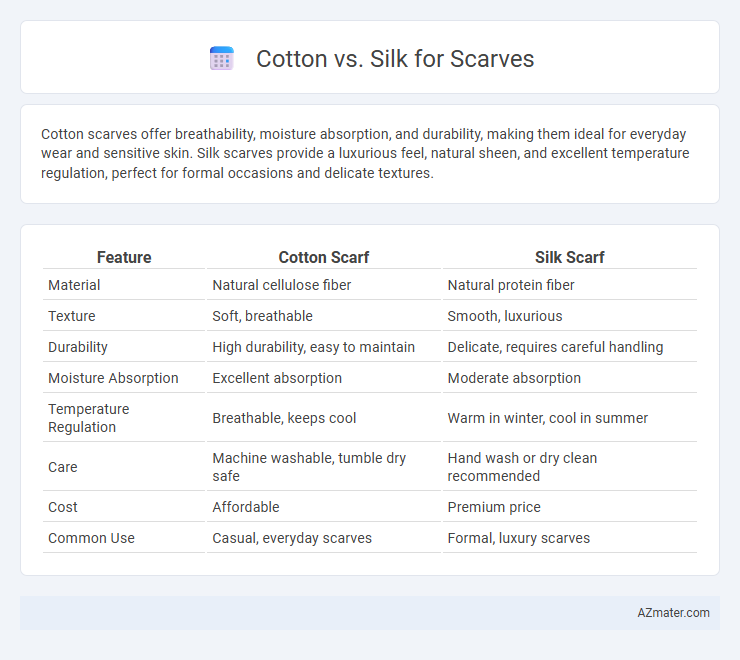Cotton scarves offer breathability, moisture absorption, and durability, making them ideal for everyday wear and sensitive skin. Silk scarves provide a luxurious feel, natural sheen, and excellent temperature regulation, perfect for formal occasions and delicate textures.
Table of Comparison
| Feature | Cotton Scarf | Silk Scarf |
|---|---|---|
| Material | Natural cellulose fiber | Natural protein fiber |
| Texture | Soft, breathable | Smooth, luxurious |
| Durability | High durability, easy to maintain | Delicate, requires careful handling |
| Moisture Absorption | Excellent absorption | Moderate absorption |
| Temperature Regulation | Breathable, keeps cool | Warm in winter, cool in summer |
| Care | Machine washable, tumble dry safe | Hand wash or dry clean recommended |
| Cost | Affordable | Premium price |
| Common Use | Casual, everyday scarves | Formal, luxury scarves |
Introduction to Cotton and Silk Scarves
Cotton scarves offer breathable comfort, durability, and easy maintenance, making them ideal for everyday wear and versatile styling. Silk scarves provide a luxurious feel with a smooth texture, natural sheen, and excellent drape, often chosen for formal occasions or adding elegance. Both materials cater to different needs, with cotton excelling in casual, temperature-regulating use, while silk stands out in softness and sophisticated appearance.
Key Differences Between Cotton and Silk
Cotton scarves are breathable, durable, and easy to care for, making them ideal for everyday wear and casual looks, while silk scarves offer a smooth texture, natural sheen, and luxurious feel, often favored for formal occasions. Cotton fibers provide moisture-wicking properties and enhanced absorbency, whereas silk fibers are hypoallergenic and temperature-regulating, keeping you cool in summer and warm in winter. The difference in fiber structure influences the scarves' weight and drape, with silk scarves being lightweight and fluid, contrasting with the slightly heavier and more structured cotton scarves.
Texture and Feel: Cotton vs Silk Scarves
Cotton scarves offer a soft, breathable texture that feels lightweight and comfortable against the skin, ideal for casual wear and warmer climates. Silk scarves provide a smooth, luxurious feel with a natural sheen, offering a cool touch that enhances elegance and drapes effortlessly. Both fabrics vary greatly in texture, with cotton delivering a matte finish and silk exuding a silky, glossy surface that adds sophistication to any outfit.
Breathability and Comfort Comparison
Cotton scarves offer exceptional breathability due to their natural fiber structure, allowing air circulation that reduces moisture and keeps the skin cool. Silk scarves, while less breathable than cotton, provide a smooth, luxurious texture that feels gentle against the skin and offers moderate temperature regulation by adapting to body heat. Choosing between cotton and silk depends on prioritizing airflow and moisture wicking in cotton or the soft, hypoallergenic comfort and elegant drape of silk.
Durability and Longevity
Silk scarves offer a luxurious feel but require delicate care to maintain their durability, as they are prone to snags and wear over time. Cotton scarves provide superior longevity, with robust fibers that withstand frequent washing and daily use without significant degradation. Choosing cotton enhances a scarf's lifespan, making it ideal for long-term, practical wear.
Maintenance and Care Requirements
Cotton scarves offer easy maintenance with machine washability and quick drying, making them ideal for everyday use. Silk scarves require delicate hand washing or dry cleaning to preserve their natural fibers and vibrant colors, demanding more careful handling. Proper storage in a cool, dry place is essential for both materials to prevent damage and extend the lifespan of the scarf.
Style and Aesthetic Appeal
Silk scarves exude a luxurious sheen and smooth texture, making them ideal for elegant, sophisticated styles and formal occasions. Cotton scarves offer a matte finish and softer, more casual aesthetic, perfect for everyday wear and versatile layering. The choice between cotton and silk scarves influences the overall vibe, with silk enhancing refined outfits and cotton complementing relaxed, bohemian looks.
Suitability for Different Seasons
Cotton scarves provide excellent breathability and moisture-wicking properties, making them ideal for warm and humid seasons as they keep the skin cool and dry. Silk scarves offer natural insulation and a smooth texture, which helps retain heat, making them suitable for cooler weather while maintaining lightweight comfort. Choosing between cotton and silk depends on the specific seasonal needs and desired temperature regulation for optimal comfort.
Allergy and Skin Sensitivity Considerations
Cotton scarves are hypoallergenic and breathable, making them ideal for individuals with sensitive skin or allergies, as they minimize irritation and allow proper air circulation. Silk scarves, while smooth and luxurious, may cause reactions in people with protein allergies due to sericin, a natural silk protein that can trigger itching or redness. Choosing cotton over silk reduces the risk of allergic responses and skin sensitivity issues, ensuring comfort for those prone to dermatological concerns.
Price and Sustainability Factors
Cotton scarves are generally more affordable, with prices ranging from $10 to $50, while silk scarves often cost between $50 and $200 due to the intricate production process. Cotton is considered more sustainable because it requires less water and chemicals than silk, which involves energy-intensive sericulture and uses mulberry leaves for silkworms. Both materials have eco-friendly versions, such as organic cotton and peace silk, enhancing their environmental appeal based on consumer priorities.

Infographic: Cotton vs Silk for Scarf
 azmater.com
azmater.com